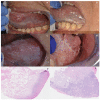Risk of Malignant Transformation in 3173 Subjects with Histopathologically Confirmed Oral Lichen Planus: A 33-Year Cohort Study in Northern Italy
- PMID: 34830892
- PMCID: PMC8616266
- DOI: 10.3390/cancers13225740
Risk of Malignant Transformation in 3173 Subjects with Histopathologically Confirmed Oral Lichen Planus: A 33-Year Cohort Study in Northern Italy
Abstract
Background: Oral lichen planus (OLP) is considered an oral potentially malignant disorder. The aim of our study was to estimate the risk for oral cancer in patients diagnosed with OLP.
Methods: A population-based cohort study between January 1988 and December 2020 at one hospital in Northern Italy was performed. The primary endpoint of the study was that of the histopathological diagnosis of oral cancer during the follow-up period.
Results: The study population comprised 3173 patients. During the follow-up period, 32 men and 50 women developed an oral squamous cell carcinoma (2.58%), with a mean time of 103.61 months after the initial diagnosis of OLP, and 21 patients died because of oral cancer. Almost half of the deceased patients had the last follow-up visit before cancer diagnosis in a period of more than 12 months. Older age, having a red form of OLP and fewer sites of involvement, increased the risk of having cancer, while age and no treatment increased the risk of death.
Conclusion: This is the largest group of OLP patients with such a long follow up ever reported. Due to the increased risk of having a malignant transformation, especially in elderly subjects, OLP patients should be regularly followed up, particularly in the Northern Italian population.
Keywords: HCV; clinical features; lichen planus; malignant transformation; outcome; survival rate; treatment.
Conflict of interest statement
The authors declare no conflict of interest.
Figures



Similar articles
-
Evaluation of Potential Risk Factors that contribute to Malignant Transformation of Oral Lichen Planus: A Literature Review.J Contemp Dent Pract. 2016 Aug 1;17(8):692-701. doi: 10.5005/jp-journals-10024-1914. J Contemp Dent Pract. 2016. PMID: 27659090 Review.
-
Malignant transformation of oral lichen planus: a retrospective study of 565 Japanese patients.BMC Oral Health. 2021 Jun 10;21(1):298. doi: 10.1186/s12903-021-01652-7. BMC Oral Health. 2021. PMID: 34112142 Free PMC article.
-
Malignant transformation of oral lichen planus. A retrospective analysis from 2003-2014: our experience.Ann Ital Chir. 2020;91:445-450. Ann Ital Chir. 2020. PMID: 33295299
-
Risk of oral squamous cell carcinoma in 402 patients with oral lichen planus: a follow-up study in an Italian population.Oral Oncol. 2004 Jan;40(1):77-83. doi: 10.1016/s1368-8375(03)00139-8. Oral Oncol. 2004. PMID: 14662419
-
Oral lichen planus has a very low malignant transformation rate: A systematic review and meta-analysis using strict diagnostic and inclusion criteria.J Oral Pathol Med. 2021 Mar;50(3):287-298. doi: 10.1111/jop.12996. Epub 2020 Feb 8. J Oral Pathol Med. 2021. PMID: 31981238
Cited by
-
Esophageal lichen planus: Current knowledge, challenges and future perspectives.World J Gastroenterol. 2022 Nov 7;28(41):5893-5909. doi: 10.3748/wjg.v28.i41.5893. World J Gastroenterol. 2022. PMID: 36405107 Free PMC article. Review.
-
An Evidence-Based Update on the Potential for Malignancy of Oral Lichen Planus and Related Conditions: A Systematic Review and Meta-Analysis.Cancers (Basel). 2024 Jan 31;16(3):608. doi: 10.3390/cancers16030608. Cancers (Basel). 2024. PMID: 38339358 Free PMC article. Review.
-
Oral Lichen Planus: A Narrative Review Navigating Etiologies, Clinical Manifestations, Diagnostics, and Therapeutic Approaches.J Clin Med. 2024 Sep 5;13(17):5280. doi: 10.3390/jcm13175280. J Clin Med. 2024. PMID: 39274493 Free PMC article. Review.
-
Rate of Malignant Transformation Differs Based on Diagnostic Criteria for Oral Lichenoid Conditions: A Systematic Review and Meta-Analysis of 24,277 Patients.Cancers (Basel). 2023 Apr 28;15(9):2537. doi: 10.3390/cancers15092537. Cancers (Basel). 2023. PMID: 37174004 Free PMC article. Review.
-
Immunomethylomic profiles of long-term head and neck squamous cell carcinoma survivors on immune checkpoint inhibitors.Epigenomics. 2024;16(11-12):799-807. doi: 10.1080/17501911.2024.2343274. Epub 2024 May 17. Epigenomics. 2024. PMID: 38869472 Free PMC article.
References
-
- Gandolfo S., Richiardi L., Carrozzo M., Broccoletti R., Carbone M., Pagano M., Vestita C., Rosso S., Merletti F. Risk of oral squamous cell carcinoma in 402 patients with oral lichen planus: A follow-up study in an Italian population. Oral Oncol. 2004;40:77–83. doi: 10.1016/S1368-8375(03)00139-8. - DOI - PubMed
-
- Carrozzo M., Uboldi de Capei M., Dametto E., Fasano M.E., Arduino P., Broccolletti R., Vezza D., Rendine S., Curtoni E.S., Gandolfo S. Tumor necrosis factor-a and interferon-g polymorphisms contribute to susceptibility to oral lichen planus. J. Investig. Dermatol. 2004;122:87–94. doi: 10.1046/j.0022-202X.2003.22108.x. - DOI - PubMed

